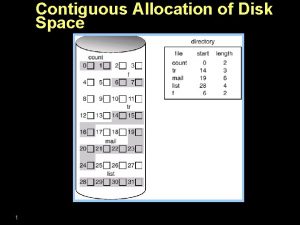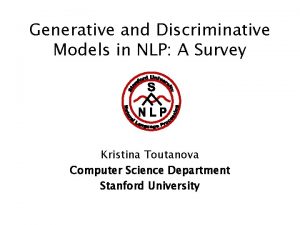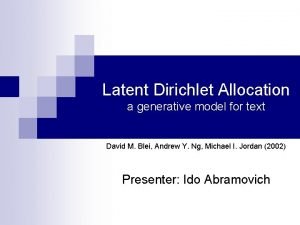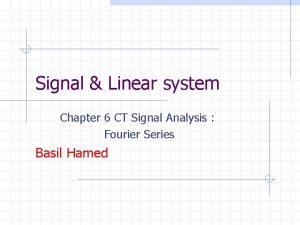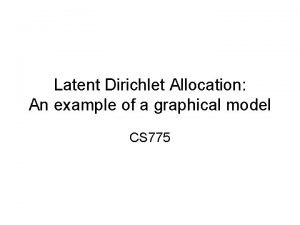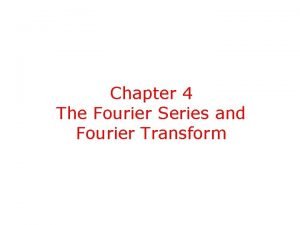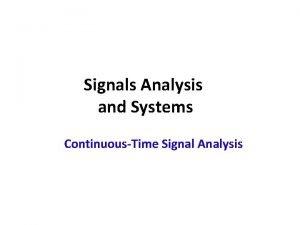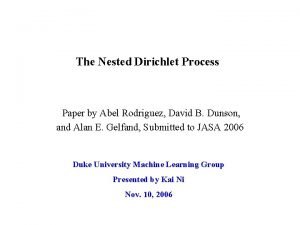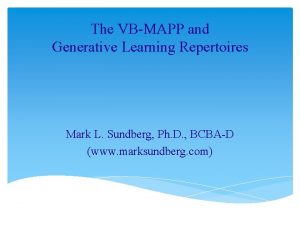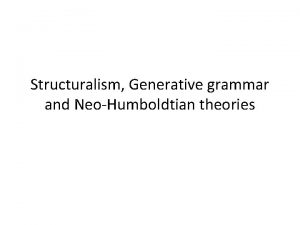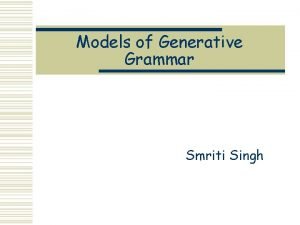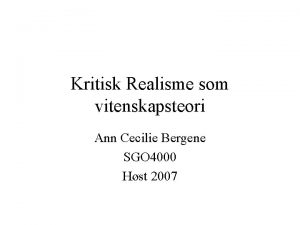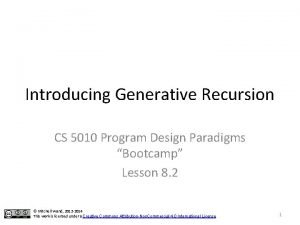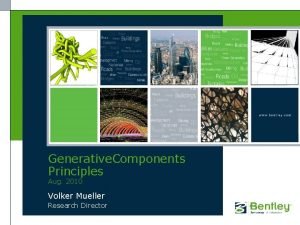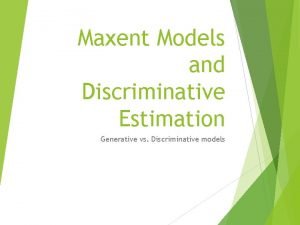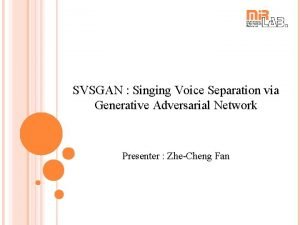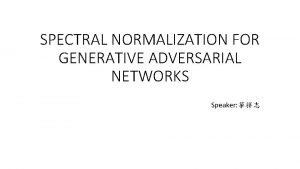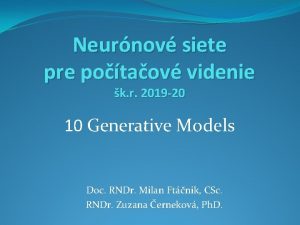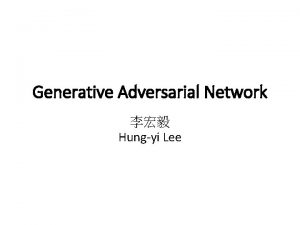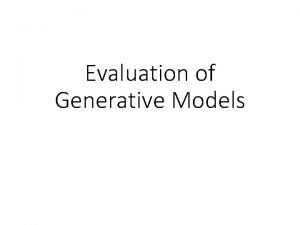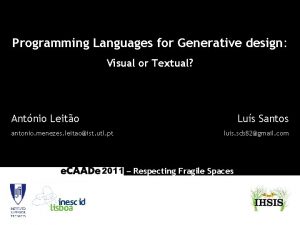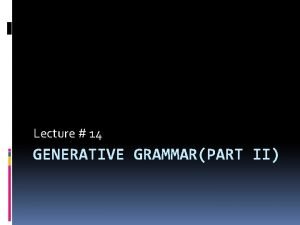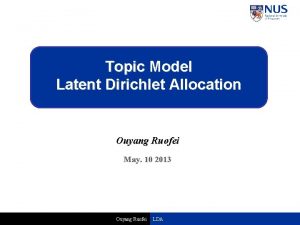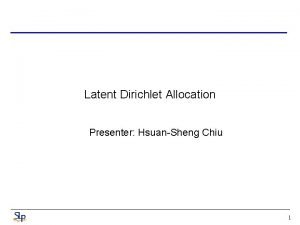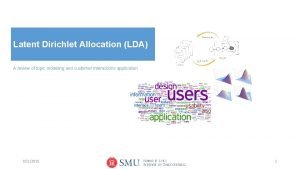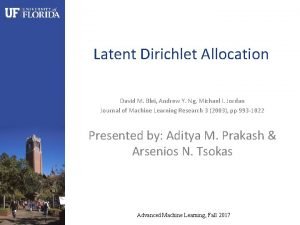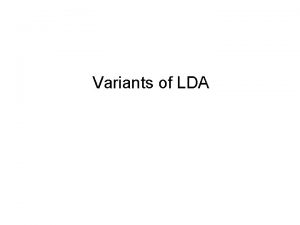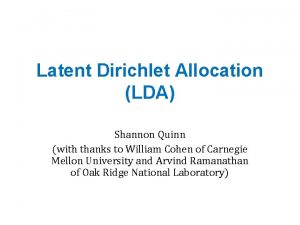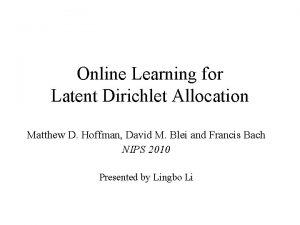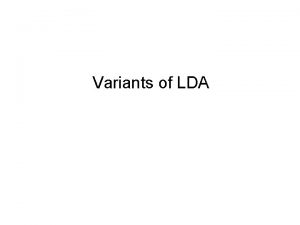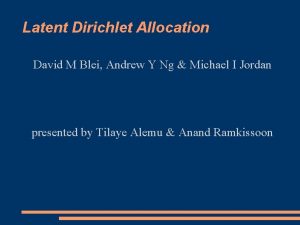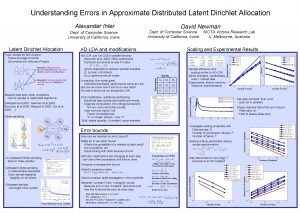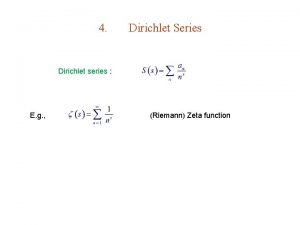Latent Dirichlet Allocation a generative model for text





































- Slides: 37

Latent Dirichlet Allocation a generative model for text David M. Blei, Andrew Y. Ng, Michael I. Jordan (2002) Presenter: Ido Abramovich

Overview n n n n Motivation Other models Notation and terminology Latent Dirichlet allocation method LDA in relation to other models A geometric interpretation The problems of estimating Example

Motivation What do we want to do with text corpora? classification, novelty detection, n summarization and similarity/relevance judgments. n Given a text corpora or other collection of discrete data we wish to: n ¨ Find a short description of the data. ¨ Preserve the essential statistical relationships

Term Frequency – Inverse Document Frequency n n n tf-idf (Salton and Mc. Gill, 1983) The term frequency count is compared to an inverse document frequency count. Results in a txd matrix – thus reducing the corpus to a fixed-length list Basic identification of sets of words that are discriminative for documents in the collection Used for search engines

LSI (Deerwester et al. , 1990) n Latent Semantic Indexing ¨ Classic attempt at solving this problem in information retrieval ¨ Uses SVD to reduce document representations ¨ Models synonymy and polysemy ¨ Computing SVD is slow ¨ Non-probabilistic model

p. LSI Hoffman (1999) n n A generative model Models each word in a document as a sample from a mixture model. Each word is generated from a single topic, different words in the document may be generated from different topics. Each document is represented as a list of mixing proportions for the mixture components.

Exchangeability n A finite set of random variables is said to be exchangeable if the joint distribution is invariant to permutation. If π is a permutation of the integers from 1 to N: n An infinite sequence of random is infinitely exchangeable if every finite subsequence is exchangeable

bag-of-words Assumption n Word order is ignored “bag-of-words” – exchangeability, not i. i. d Theorem (De Finetti, 1935) – if are infinitely exchangeable, then the joint probability has a representation as a mixture: For some random variable θ

Notation and terminology n n n A word is an item from a vocabulary indexed by {1, …, V}. We represent words using unit-basis vectors. The vth word is represented by a Vvector w such that and for A document is a sequence of N words denoted by , where is the nth word in the sequence. A corpus is a collection of M documents denoted by

Latent Dirichlet allocation n LDA is a generative probabilistic model of a corpus. The basic idea is that the documents are represented as random mixtures over latent topics, where a topic is characterized by a distribution over words.

LDA – generative process 1. 2. 3. Choose For each of the N words : Choose a topic (b) Choose a word from , a multinomial probability conditioned on the topic (a)

Dirichlet distribution n A k-dimensional Dirichlet random variable θ can take values in the (k-1)-simplex, and has the following probability density on this simplex:

The graphical model

The LDA equations

LDA and exchangeability n n n We assume that words are generated by topics and that those topics are infinitely exchangeable within a document. By de Finetti’s theorem: By marginalizing out the topic variables, we get eq. 3 in the previous slide.


Unigram model

Mixture of unigrams

Probabilistic LSI

A geometric interpretation word simplex

A geometric interpretation topic 1 topic simplex word simplex topic 2 topic 3

A geometric interpretation topic 1 topic simplex word simplex topic 2 topic 3

A geometric interpretation topic 1 topic simplex word simplex topic 2 topic 3

Inference n We want to compute the posterior dist. Of the hidden variables given a document: n Unfortunately, this is intractable to compute in general. We write Eq. (3) as:

Variational inference

Parameter estimation n Variational EM ¨ (E Step) For each document, find the optimizing values of the variational parameters (γ, φ) with α, β fixed. ¨ (M Step) Maximize variational distribution w. r. t. α, β for the γ and φ values found in the E step.

Smoothed LDA n n n Introduces Dirichlet smoothing on β to avoid the “zero frequency problem” More Bayesian approach Inference and parameter learning similar to unsmoothed LDA


Document modeling n n . Unlabeled data – our goal is density estimation. Compute the perplexity of a held-out test to evaluate the models – lower perplexity score indicates better generalization.

Document Modeling – cont. data used n C. Elegans Community abstracts ¨ 5, 225 abstracts ¨ 28, 414 unique terms n TREC AP corpus (subset) ¨ 16, 333 newswire articles ¨ 23, 075 unique terms n n Held-out data – 10% Removed terms – 50 stop words, words appearing once (AP)

nematode

AP

Document Modeling – cont. Results n n n Both p. LSI and mixture suffer from overfitting. Mixture – peaked posteriors in the training set. Can solve overfitting with variational Bayesian smoothing. Perplexity Num. topics (k) Mult. Mixt. 2 22, 266 7, 052 5 2. 20 x 108 17, 588 10 1. 93 x 1017 63. 800 20 1. 20 x 1022 2. 52 x 105 50 4. 19 x 10106 5. 04 x 106 100 2. 39 x 10150 1. 72 x 107 200 3. 51 x 10264 1. 31 x 107 p. LSI

Document Modeling – cont. Results n n n Both p. LSI and mixture suffer from overfitting. p. LSI – overfitting due to dimensionality of the p(z|d) parameter. As k gets larger, the chance that a training document will cover all the topics in a new document decreases Perplexity Num. topics (k) Mult. Mixt. 2 22, 266 7, 052 5 2. 20 x 108 17, 588 10 1. 93 x 1017 63. 800 20 1. 20 x 1022 2. 52 x 105 50 4. 19 x 10106 5. 04 x 106 100 2. 39 x 10150 1. 72 x 107 200 3. 51 x 10264 1. 31 x 107 p. LSI

Other uses

Summary Based on the exchangeability assumption n Can be viewed as a dimensionality reduction technique n Exact inference is intractable, we can approximate instead n Can be used in other collection – images and caption for example. n

 Define specific latent heat
Define specific latent heat Linked allocation
Linked allocation What is an example of a text-to-media connection?
What is an example of a text-to-media connection? I gullregnens månad
I gullregnens månad Nlp generative model
Nlp generative model Lda generative model
Lda generative model Dirichlet box principle
Dirichlet box principle Dirichlet's box principle
Dirichlet's box principle Dirichlet conditions
Dirichlet conditions Series de fourier
Series de fourier Dirichlet discontinuous factor
Dirichlet discontinuous factor Gibbs sampling example
Gibbs sampling example Dirichlet condition for fourier series expansion
Dirichlet condition for fourier series expansion Define fourier series
Define fourier series Nested dirichlet process
Nested dirichlet process Lrffc aba meaning
Lrffc aba meaning Generative grammar
Generative grammar Generative grammar
Generative grammar Eksempler på kritisk realisme
Eksempler på kritisk realisme Generative recursion
Generative recursion Deep and surface structure examples
Deep and surface structure examples Bentley generative components
Bentley generative components Dilan gorur
Dilan gorur Hudson culture ladder
Hudson culture ladder Generative lymphoid organs
Generative lymphoid organs Generative thinking boards
Generative thinking boards Quantum generative adversarial learning
Quantum generative adversarial learning Generative vs discriminative
Generative vs discriminative Structural linguistic and behavioral psychology
Structural linguistic and behavioral psychology Singing
Singing Spectral normalization gan
Spectral normalization gan Taxonomy of generative models
Taxonomy of generative models Conditional generator
Conditional generator Lucas theis
Lucas theis Generative meditation
Generative meditation Advantages of capp
Advantages of capp Generative design grasshopper
Generative design grasshopper Generative grammar examples
Generative grammar examples

